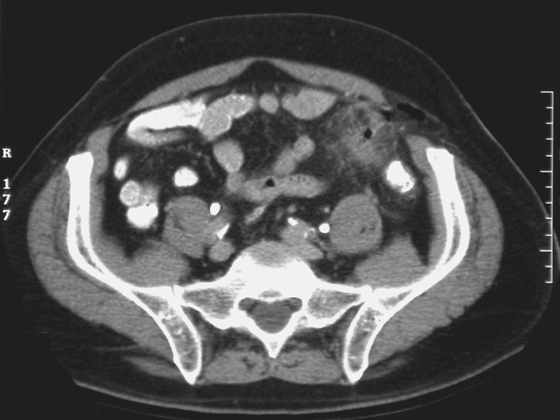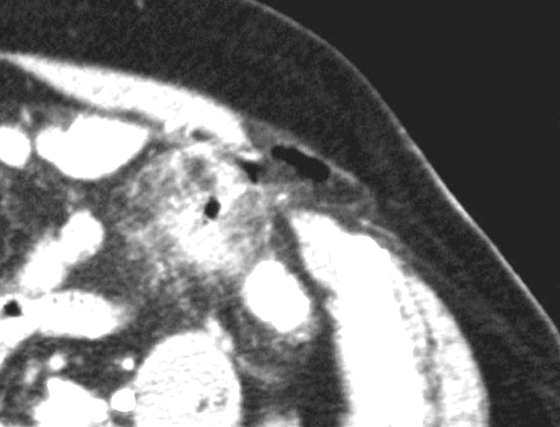CASE 83



History: A 66-year-old man presents with left flank pain.
1. Which of the following should be included in the differential diagnosis of the imaging finding shown in the figures? (Choose all that apply.)
2. What is the examination of choice in a patient with an abdominal stab injury?
3. Which of the following statements about abdominal stab injuries is true?
A. The colon is often involved in stab injuries.
B. The most commonly injured viscus is the spleen.
C. Stab injuries are less common than gunshot injuries.
D. The liver and spleen protect the diaphragm from stab injury.
4. Which of the following statements about abdominal gunshot injuries is true?
A. The most commonly injured viscus is the spleen.
B. Gunshot wounds are responsible for most of the fatalities of penetrating abdominal injuries.
C. Upper abdominal wounds are difficult to evaluate owing to the subtlety of injury to the pancreas.
ANSWERS
CASE 83
Colonic Trauma: Stab Wound
1. A, B, D, and E
2. C
3. A
4. B
References
Goodman CS, Hur JY, Adajar MA, Coulam CH. How well does CT predict the need for laparotomy in hemodynamically stable patients with penetrating abdominal injury? A review and meta-analysis. Am J Roentgenol. 2009;193:432–437.
Cross-Reference
Gastrointestinal Imaging: THE REQUISITES, 3rd ed, p 300.
Comment
CT imaging, especially multidetector CT imaging, is the examination of choice in penetrating abdominal trauma when the patient is hemodynamically stable (see figures). Penetrating wounds are mostly stab wounds and bullet wounds. When the hollow viscus is penetrated, not only blood can be spilled into the peritoneal cavity but also the content of the hollow viscus. Small collections of air or bubbles must be accounted for. If it is determined that the air collections or bubbles are outside the bowel, and there has been no other cause for such a finding (recent surgery or peritoneal lavage), then a breeching injury of the bowel must be presumed. It is possible for bowel to be injured but not necessarily penetrated. This is usually seen as blood in the bowel wall. Some small amount of bleeding into the peritoneal cavity can occur even in this situation. Penetration of the colon will lead to widespread peritonitis, sepsis, and death within a few days. The morbidity and mortality rates for stab wounds depend entirely on how early diagnosis and surgical intervention occur. Penetrating trauma to the abdomen accounts for about 30% of patients in urban trauma centers and less than half that in suburban centers.







